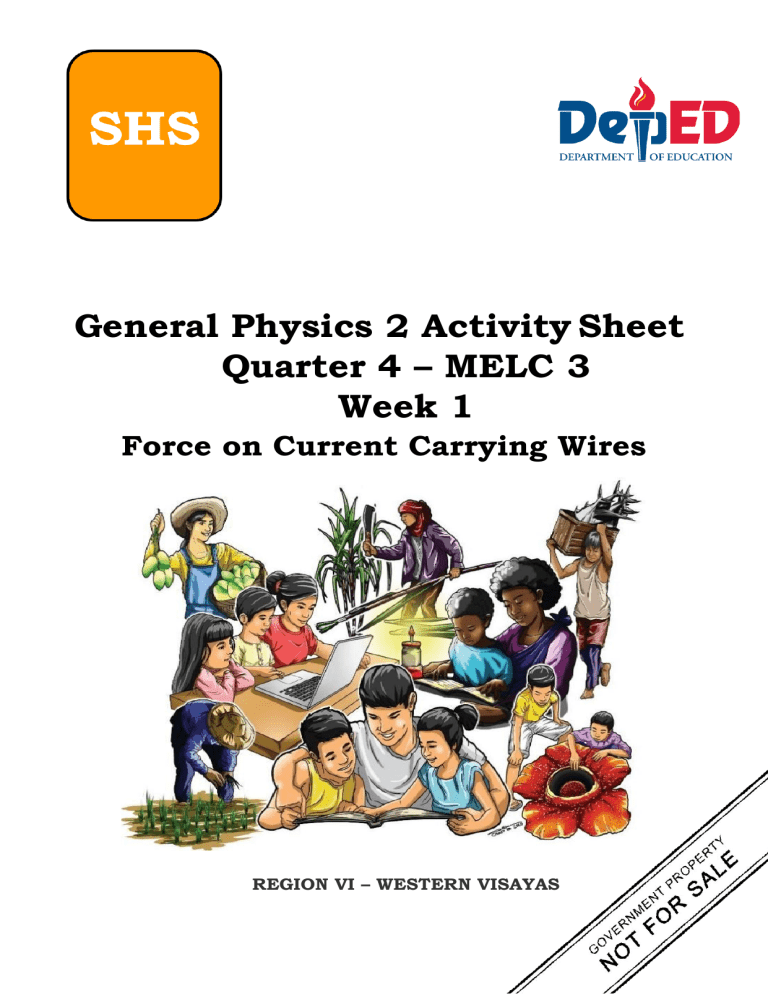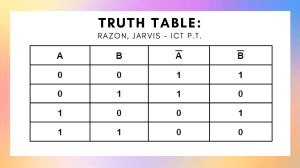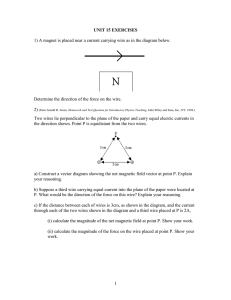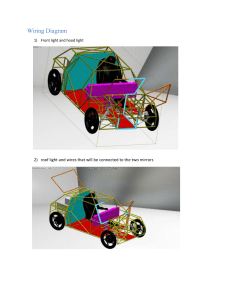
General Physics 2 Activity Sheet Quarter 4 – MELC 3 Week 1 Force on Current Carrying Wires REGION VI – WESTERN VISAYAS 1 General Physics 2 Activity Sheet No. 3: Force on Current Carrying Wires First Edition, 2021 Published in the Philippines By the Department of Education Region 6 – Western Visayas Republic Act 8293, section 176 states that: No copyright shall subsist in any work of the Government of the Philippines. However, prior approval of the government agency or office wherein the work is created shall be necessary for exploitation of such work for profit. Such agency or office may, among other things, impose as a condition the payment of royalties. This Learning Activity Sheet is developed by DepEd Region 6 – Western Visayas. ALL RIGHTS RESERVED. No part of this learning resource may be reproduced or transmitted in any form or by any means electronic or mechanical without written permission from the DepEd Regional Office 6 – Western Visayas. Development Team of General Physics 2 Activity Sheet Writer: Joemarie S. Selibio Editors: Jave N. Salinas Glenn Mark D. Fallera Schools Division Quality Assurance Team: Mary Regina N. Alkonga Noemi A. Salvador Stella J. Tacuyan Division of Iloilo City Management Team: Ma. Luz M. De Los Reyes Ernesto F. Servillon Jr. Arlo L. Villalva Leila G. Valencia Regional Management Team: Ramir B. Uytico Pedro T. Escobarte, Jr. Elena P. Gonzaga Donald T. Genine Rovel R. Salcedo Moonyeen C. Rivera Anita S. Gubalane Minda L. Soldevilla Daisy L. Lopez Joseph M. Pagalaran ii Introductory Message Welcome to General Physics 2 for Grade 12! The Learning Activity Sheet is a product of the collaborative efforts of the Schools Division of Iloilo City and DepEd Regional Office VI - Western Visayas through the Curriculum and Learning Management Division (CLMD). This is developed to guide the learning facilitators (teachers, parents and responsible adults) in helping the learners meet the standards set by the K to 12 Basic Education Curriculum. The Learning Activity Sheet is self-directed instructional materials aimed to guide the learners in accomplishing activities at their own pace and time using the contextualized resources in the community. This will also assist the learners in acquiring the lifelong learning skills, knowledge and attitudes for productivity and employment. For learning facilitator: The General Physics 2 Activity Sheet will help you facilitate the teachinglearning activities specified in each Most Essential Learning Competency (MELC) with minimal or no face-to-face encounter between you and learner. This will be made available to the learners with the references/links to ease the independent learning. For the learner: The General Physics 2 Activity Sheet is developed to help you continue learning even if you are not in school. This learning material provides you with meaningful and engaging activities for independent learning. Being an active learner, carefully read and understand the instructions then perform the activities and answer the assessments. This will be returned to your facilitator on the agreed schedule. iii Name of Learner: ___________________________________________________ Grade and Section:_______________________________Date: ________________ GENERAL PHYSICS 2 ACTIVITY SHEET No. 3 Force Per Unit Length on Current Carrying Wires I. Learning Competency with Code Calculate the force per unit length on a current carrying wire due to the magnetic field produced by other current-carrying wires. STEM_GP12EMIIIi-63 II. Background Information for Learners When current Carrying conductors are close to one another they produce a Magnetic Field as well as Magnetic Force that may affect one another. Consider Figure 1 below. Figure 1. Two current carrying wires separated by distance dy producing Magnetic Fields and Forces. If two currents are of the same direction they attract. However, they repel when currents are on opposite direction. Considering the upper wire, you can determine the magnitude of lower wire’s magnetic field using the formula ⃗𝑩 ⃗ = µ𝒐 𝑰𝟐 (eq. 1) 𝟐𝝅𝒅𝒚 You can also determine the Force that this field exert on the upper conductor ⃗ 𝑥𝐼1 𝐿 , where I1 refers to the current on conductor 1 and L using the formula 𝐹 = 𝐵 for the length of the wire influenced by Magnetic Field. You can therefore determine the Magnitude of Force using the equation 𝐹 = 𝐵𝐼1 𝐿 (eq. 2) Getting the ratio F/L will result to an equation 𝐹 = 𝐵𝐼1 (eq.3) 𝐿 1 Substituting the magnitude of equation 1 to equation 3 will result to 𝐹 µ𝒐 𝑰𝟐 = 𝑰 𝐿 𝟐𝝅𝒅𝒚 𝟏 The equation above is the Force per unit Length considering two long, parallel current carrying conductors. Take note that when two currents are moving in the same direction in a straight current carrying conductor parallel to each other they will produce an attractive force. However, when two currents are moving in the opposite direction they will repel each other. III. Activity Proper Activity 1 Directions: • Study the Ideas and the Sample problems presented. • Complete the data by computing F/L in the assigned task • Express your answer in scientific notation with two significant figures • Analyze and answer the guide questions. • Write your answer on a separate sheet of paper. Sample Problem 1 Peter, a STEM student from Iloilo City, is conducting an investigatory project related to forces on current carrying wires would like to determine the ratio of F/L between two wires by setting up two long and straight parallel wires 0.07 m apart from each other. He also allows each wire to receive the same amount of current equal to 30 A. What value of F/L will be obtained by Peter? Solution Given: Distance between wires (dy)= 0.07 m I1 =I2 = 30A Asked: F/L Process: 𝐹 µ 𝒐 𝑰𝟐 (𝟒𝜋𝑥10 = 𝑰𝟏 = 𝐿 𝟐𝝅𝒅𝒚 −7 𝑇. 𝑚/𝐴)(30𝐴)(30𝐴) = 𝟐. 𝟔𝒙𝟏𝟎−𝟑 𝑵/𝒎 𝟐𝜋(0.07) 2 Case: Peter is a STEM student from Iloilo City who is trying to evaluate the relationship of variables considering the Magnetic Forces experienced by two long and straight current carrying wires. In his experiment, he varied some variables and observed what will happen to the ratio F/L. Task 1: The F/L when current I2 is varied (Notice that Peter varied the magnitude of I2) µ𝒐 𝟐𝝅 dy (meters) I1 (Ampere ) I2 (Ampere ) 4𝜋 x10-7 Tm/A 6.28 0.07 30 30 4𝜋 x10-7 Tm/A 6.28 0.07 30 60 4𝜋 x10-7 Tm/A 6.28 0.07 30 90 4𝜋 x10-7 Tm/A 6.28 0.07 30 120 F/L (N/m) Task 2: The F/L When Both Current I is Varied (Notice that Peter varied the magnitude of both I) µ𝒐 𝟐𝝅 dy (meters) I1 (Ampere ) I2 (Ampere ) 4𝜋 x10-7 Tm/A 6.28 0.07 30 30 4𝜋 x10-7 Tm/A 6.28 0.07 60 60 4𝜋 x10-7 Tm/A 6.28 0.07 90 90 4𝜋 x10-7 Tm/A 6.28 0.07 120 120 3 F/L (N/m) Task 3: The F/L When the distance between two wires is Varied (Notice that Peter varied the distance of separation between current carrying wires) µ𝒐 𝟐𝝅 dy (meters) I1 (Ampere ) I2 (Ampere ) 4𝜋 x10-7 Tm/A 6.28 0.07 30 30 4𝜋 x10-7 Tm/A 6.28 0.14 30 30 4𝜋 x10-7 Tm/A 6.28 0.21 30 30 4𝜋 x10-7 Tm/A 6.28 0.28 30 30 F/L (N/m) Guide Questions 1. How will you describe the relationship that exist between F/L and the Magnitude of Current on the second wire? ______________________________________________________________ ______________________________________________________________ 2. How will you describe the relationship that exist between F/L and the Magnitude of Current’s Product? ______________________________________________________________ ______________________________________________________________ 3. How will you describe the relationship that exist between F/L and the distance between two wires? ______________________________________________________________ ______________________________________________________________ IV. Reflection I understand ___________________________________________________________ ___________________________________________________________ I don’t understand ___________________________________________________________ ___________________________________________________________ I need more information about ___________________________________________________________ ___________________________________________________________ 4 5 B. The F/L When Both Current I is Varied (Notice that Peter varied the magnitude of both I) 6.28 4𝜋x10-7 Tm/A 6.28 4𝜋x10-7 Tm/A 6.28 4𝜋x10-7 Tm/A 6.28 4𝜋x10-7 Tm/A 𝟐𝝅 µ𝒐 dy (meters) 0.07 0.07 0.07 0.07 120 120 90 90 60 60 30 30 I2 (Ampere) I1 (Ampere) F/L (N/m) 2.6𝑥10−3 𝑁 /𝑚 1.0𝑥10−2 𝑁 /𝑚 2.3𝑥10−2 𝑁 /𝑚 4.1𝑥10−3 𝑁 /𝑚 A. The F/L When Current I2 is Varied (Notice that Peter varied the magnitude of I2 ) 6.28 4𝜋x10-7 Tm/A 6.28 4𝜋x10-7 Tm/A 6.28 4𝜋x10-7 Tm/A 6.28 4𝜋x10-7 Tm/A 𝟐𝝅 µ𝒐 dy (meters) 0.07 0.07 0.07 0.07 120 30 90 30 5.1𝑥10−3 𝑁 /𝑚 60 30 2.6𝑥10−3 𝑁 /𝑚 30 30 I2 (Ampere) I1 (Ampere) F/L (N/m) 7.7𝑥10−3 𝑁 /𝑚 1.0𝑥10−2 𝑁 /𝑚 V. Answer Key 6 2. Guide Questions 1. How will you describe the relationship that exist between F/L and the Magnitude of Current on the second wire? Ans. As the magnitude of current on the second wire increases, the value of F/L also increases. 2. How will you describe the relationship that exist between F/L and the Magnitude of Current’s Product? Ans. As the Product of both current increases, the value of F/L also increases. 3. How will you describe the relationship that exist between F/L and the distance between two wires? Ans. As the distance between the first and the second wire increases, the value of F/L decreases. C. The F/L When the distance between two wires is Varied (Notice that Peter varied the distance of separation between current carrying wires) 6.28 4𝜋x10-7 Tm/A 6.28 4𝜋x10-7 Tm/A 6.28 4𝜋x10-7 Tm/A 6.28 4𝜋x10-7 Tm/A 𝟐𝝅 µ𝒐 30 0.28 30 0.21 30 0.14 30 30 0.07 I2 (Ampere) I1 (Ampere) dy (meters) 30 30 30 F/L (N/m) 2.6𝑥10−3 𝑁 /𝑚 1.3𝑥10−3 𝑁 /𝑚 8.6𝑥10−4 𝑁 /𝑚 6.4𝑥10−4 𝑁 /𝑚 VI. Link and other References “Resnick, Halliday, Krane: Physics, Volume 1, 5th Edition - Student Companion Site.” Wiley.com,2021.http://bcs.wiley.com/hebcs/Books?action=index&itemId=04713 20579&itemTypeId=BKS&bcsId=1458. book-info.com – Sascha Hendel. “3,000 Solved Problems in Physics – Schaum’s Solved Problems Series [McGraw-Hill: First Edition].” book-info.com, 2011. https://www.book-info.com/isbn/0-07-025734-5.htm. “University Physics with Modern Physics | Hugh D. Young, Roger A. Freedman | Download.” 1lib.ph. Z-Library, 2015. https://1lib.ph/book/604468/daf477?regionChanged=&redirect=182684539. “Physics for Scientists & Engineers : Serway, Raymond a : Free Download, Borrow, and Streaming : Internet Archive.” Internet Archive, 2014. https://archive.org/details/physicsforscient00serw. “Calculate Force per Unit Length Acting on the Wire B due to the Current Flowing in the Wire A.” Toppr Ask, 2019. https://www.toppr.com/ask/question/calculate-force-per-unit-length-acting-onthe-wire-b/. “Zigya - for the Curious Learner.” Zigya.com, 2021. https://www.zigya.com/study/book?class=12&board=cbse&subject=Physics&b ook=Physics+Part+I&chapter=Moving+Charges+And+Magnetism&q_type=&q_ topic=Magnetic+Force&q_category=&question_id=PHEN12049901. 7



